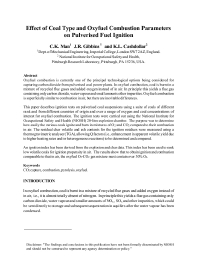 |
Oxyfuel combustion is currently one of the principal technological options being considered for capturing carbon dioxide from pulverised coal power plants. In oxyfuel combustion, coal is burnt in a mixture of recycled flue gases and added oxygen instead of in air. In principle this yields a flue gas containing only carbon dioxide, water vapour and small amounts other impurities. Oxyfuel combustion is superficially similar to combustion in air, but there are inevitable differences. This paper describes ignition tests on pulverised coal suspensions using a suite of coals of different rank and from different countries of origin and over a range of oxygen and coal concentrations of interest for oxyfuel combustion. The ignition tests were carried out using the National Institute for Occupational Safety and Health (NIOSH) 20-litre explosion chamber. The purpose was to determine how easily the various coals ignite and burn in mixtures of O2 and CO2 compared to their combustion in air. The residual char volatile and ash contents for the ignition residues were measured using a thermogravimetric analyser (TGA), allowing Q factors (i.e., enhancement in apparent volatile yield due to higher heating rates and/or heterogeneous reactions) to be determined and compared. An ignition index has been derived from the explosion and char data. This index has been used to rank low volatile coals for ignition propensity in air. The results show that to obtain ignition and combustion comparable to that in air, the oxyfuel O2-CO2 gas mixture must contain over 30% O2.
| Author(s): | Man-C, Gibbons-JR, Cashdollar-KL |
| Reference: | 2007 International Conference on Coal Science and Technology, August 28-31, 2007, Nottingham, United Kingdom. Nottingham, U.K.: University of Nottingham, School of Chemical and Environmental Engineering, Nottingham Fuel and Energy Centre, 2007 Aug; :1-9 |
eocta (PDF, 112 KB)